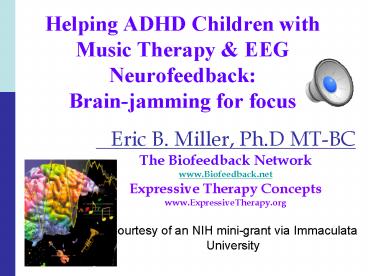Helping ADHD Children with Music Therapy - PowerPoint PPT Presentation
Title:
Helping ADHD Children with Music Therapy
Description:
Star Wars Neurofeedback. Measures. The Conners' CPT. Stroop, Nepsy exec sub-scale, Toni-3 ... published author and presents internationally on music & healing. ... – PowerPoint PPT presentation
Number of Views:226
Avg rating:3.0/5.0
Title: Helping ADHD Children with Music Therapy
1
Helping ADHD Children with Music Therapy EEG
NeurofeedbackBrain-jamming for focus
Eric B. Miller, Ph.D MT-BC The Biofeedback
Network www.Biofeedback.net Expressive Therapy
Concepts www.ExpressiveTherapy.org
- Courtesy of an NIH mini-grant via Immaculata
University
2
Brain Function Music
3
- The Center for Disease Control Prevention (CDC)
describes ADHD as a neurobehavioral disorder
characterized by pervasive inattention and/or
hyperactivity-impulsivity and resulting in
significant functional impairment (CDC, 2005,
p. 1).
4
Star Wars Neurofeedback
5
Measures
Inclusion Criteria
- 8-14 years old collateral data from their
parents, teachers, healthcare professionals. - Formally diagnosed with ADHD by a licensed
psychologist, psychiatrist or medical doctor with
or without the H. - Does Not have other axis 1 Dx
- Not taking medications that would confound the EEG
- The Conners CPT
- Stroop, Nepsy exec sub-scale, Toni-3
- Quantitative electroencephalography (QEEG)
- Monopolar EEG session data
- Pre, mid and post-session questionnaires
- Qualitative interviews
6
Brain-Maps
QEEG Pre-Post
Note a pattern of normalization across all bands,
with significant reduction in significantly hot
Delta, Beta and high Beta rhythms.
7
Baseline
Brain Maps
Single-subject QEEG BASELINE vs. IMPROV MUSIC
Improvising Music
8
Discriminant Analysis
Note that the probability of inclusion in the LD
population has decreased from 99 to 60.
Pre vs. Post-Intervention
9
Discriminant Analysis
During IMPROV music (playing) LD probability
drops to not significant at Post-Intervention.
10
Between Group Differences
- Control vs. 3 NF
Groups
11
NEPSY Results NF-MUS group
12
Trend toward improvement
13
TONI-3 Results NF-MUS group
14
CPT Results NF-MUS group
15
Eric B. Miller, Ph.D. miller_at_biofeedback.net
Abstract p. 1 GETTING FROM PSY-PHY
(PSYCHOPHYSIOLOGY) TO MEDICAL POLICY VIA MUSIC
AND NEUROFEEDBACK FOR ADHD CHILDREN Eric B.
Miller Abstract Within the backdrop of a
societal healthcare paradigm swing, this study of
EEG neurofeedback with music therapy protocols
added an experimental group (NF-MUS) to an
existing Philadelphia Office for Mental Health
multi-site study of two traditional neurofeedback
(NF) protocols. Thirty-eight subjects completed
the pre- and post intervention assessment
comprised of the Stroop, Toni-3, NEPSY
Attention/Executive core domain score, Conners
CPT and ADHD Parent and Teacher Rating Scales
Revised (S). NF-MUS subjects also received pre-
and post-quantitative EEG (QEEG) topographical
brain-mapping. NF-MUS utilized a Theta/Beta
protocol variation, incorporating brain-triggered
musical tones assigned to Theta amplitude in key
with background musical selections.
Individual results within the NF-MUS group showed
improvement on NEPSY core domain scores and
improvement individually on the Stroop Color and
Word tests, but showed mixed results on the
combined Stroop Color/Word test. Three out of
four NF-MUS subjects improved their TONI
quotient. CPT results were mixed, with
some individuals displaying dramatic improvement
on the CPTs ADHD index score. A paired
samples T-test showed no significant differences
between pre- and post-Toni-3 scores or Stroop
Color/Word scores. Significant improvement was
found for the Stroop Color and Stroop Word scores
individually and for the NEPSY Executive
Function/Attention subscale index scores.
16
Eric B. Miller, Ph.D. miller_at_biofeedback.net
Abstract p. 2 Between-group analysis showed the
NF-MUS group significantly superior to the other
NF groups and control subjects on three measures
the NEPSY audio subtest (p .01) the Conners
Parent Rating Scale ADHD index (p .015) and,
the Conners Parent Survey Cognitive subscale (p
.043). Differences in QEEG brain maps ranged from
very little change pre- and post-intervention to
noticeable normalization patterns. NF-MUS
subjects decreased their Theta/Beta ratio
(p.004) and increased their SMR (p.012) as
hypothesized. Theta reduction alone, however, was
not significant (p.189). These results indicate
that a brain-triggered musical component to
neurofeedback protocols may yield superior
remediation of ADHD symptoms than standard
neurofeedback protocols. Acceptance of these
results and incorporation of findings into
clinical practice, however, is unlikely until
further investigation corroborates these results,
and medical community attitudes continue to shift
in the direction of holistic therapies.
Dr. Eric Miller is a psychotherapist, certified
biofeedback therapist and board-certified music
therapist with experience in inpatient,
outpatient, corporate and educational settings.
He instructs in capacity of adjunct faculty and
guest lectures at such institutions as Immaculata
University, Antioch University, Bryn Mawr
College, Harcum College, Allegheny University
(formerly Hahnemann) and at the Naropa Institute.
He is a published author and presents
internationally on music healing. Dr. Miller
was appointed Executive Director of Music for
People in 1997 and has served as President of
Expressive Therapy Concepts since 1993. He also
directs the Association for Integrative Medicine
and the Biofeedback Network. Dr. Miller can be
reached at miller_at_biofeedback.net
17
All subjects Baselinevs.Improv

